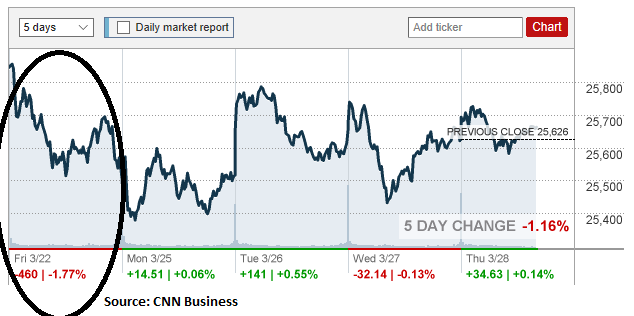Just when it was safe for investors to delve back into U.S. equities in 2019, fears of a global economic slowdown reminded investors that volatility was still lurking in the shadows of the capital markets and getting tactical was not to be ignored, especially when it comes to exchange-traded funds (ETFs). One way to ease the bumpy ride of volatility moving forward is the VictoryShares US Multi-Factor Minimum Volatility ETF (NasdaqGM: VSMV).
VSMV seeks to provide investment results that track the performance of the Nasdaq Victory US Multi-Factor Minimum Volatility Index. The index itself utilizes a rules-based approach designed to help generate investment returns with less volatility than the broader U.S. market.
The prime focus of less volatility is something investors could have used when the notion of slowing global growth permeated the markets on March 22, resulting in a 460-point loss. Adding to the wall of worry was also fears of an inverted yield curve. The intent is to dampen downside and smooth the overall experience.

Fear the Inversion Curve
Fears of an inverted yield curve racked the markets during 2018’s fourth quarter sell-off, but returned in March as the short-term 3-month and longer-term 10-year yield curve did as such–unveil an inversion that hasn’t been seen since 2007–just ahead of the financial crisis.
The spread between the 3-month and 10-year notes fell below 10 basis points for the first time in over a decade. The capital markets are just a week removed from the U.S. Federal Reserve keeping rates steady, but fears of a global economic slowdown are already manifesting themselves in various forms. In the U.S., it’s taking the form of an inverted yield curve, which could spur even more cautiousness by the central bank.
With the sports world abuzz in college basketball tournaments, the capital markets have been experiencing their own version of “March Madness” with a wild ride to the downside after a strong start to 2019.

The Quality Comeback
The fourth quarter of 2018 saw investors flocking to safe haven assets like bonds, there’s still a need for products that capture the upside potential in U.S. equities. At the same time, however, there’s also a need for strategies that offer downside protection built into the product.
As a result of 2018’s bull market run, the quality factor often goes overlooked compared to growth and value, but with market volatility still a primary consideration and many investors favoring defensive sectors, quality stocks and the related ETFs are worth examining in 2019.
Quality, in particular, is something that Victory Shares president Mannik Dhillon, is able to see through the market murkiness in 2019 and beyond.
Quality, in particular, is something that VictoryShares president Mannik Dhillon, is able to see through the market murkiness in 2019 and beyond.
“One thing we’re noticing from clients is the resurgence of a demand for quality,” said Dhillon. “We see that the market and investors are now more discerning about what they are buying rather than just saying, ‘I need to buy.'”
No longer fueled by the adrenaline-rushing returns of growth and momentum, investors had to reacquaint themselves with value thus far in 2019.
“Value investing is not dead,” said Dhillon. “Paying smart prices for good companies is still correct, but the way you measure, or define value, may evolve over time.”
Even during the volatile moments of the market, investors were quick to react to news–trade wars, inverted yield curves and now government shutdowns. It’s the type of noise that muddies the minds of investors and disconnects them from the fundamentals of an asset.
By focusing on a multi-factor approach, VSMV can hone in on holdings that exhibit the right factor exposures, such as quality, momentum and profitability, but compared to other products, also take into consideration valuation. This approach helps, particularly when traditional low volatility sectors and stocks are “bid up” by the market at times.
As such, it can help minimize volatility when markets undergo drawdowns, but still capture upside as seen in the fund’s 8.99 percent return year-to-date, according to Morningstar performance numbers.
Characteristics of VSMV:
- Seeks to provide a smoother path to long-term capital appreciation.
- A next-generation approach to low-volatility investing, as stocks are selected based on a multi-factor screening process, and then the portfolio is optimized with the goal of minimizing volatility.
- A disciplined, low-cost exposure to core US equities while seeking to minimize overall portfolio risk.
- Designed to be used as core portfolio or broad market replacement.
Speaking to the third bullet point of VSMV, not only are investors looking to play more defense against volatility–at the same time, they don’t want to do so at the expense of higher costs.
Of course, with a plethora of options available, especially in the exchange-traded fund (ETF) space, where are the opportunities given the current market landscape? Can an investor really build a defensive portfolio at a low premium?
With its ability to smoothen out volatility, VSMV does so at a net expense ratio of 0.35 percent and a gross expense ratio at 0.74 percent.
For more market trends, visit ETF Trends.
